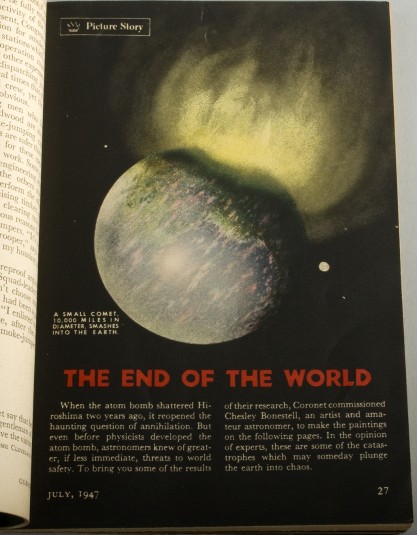


In 1947–as the world reeled from the scale of the devastation caused by the Atomic bombs dropped on Hiroshima and Nagasaki in 1945 and an increasing Cold War threat of nuclear annihilation–Coronet Magazine commissioned Chesley Bonestell to illustrate a haunting “picture story” that showcased eight different catastrophes which could bring upon an end to life as we know it. Known by the magazine as an amateur astronomer, Bonestell was a perfect choice to evoke the potential chaos of an earth split apart from the moon or captured by the gravitational pull of a white dwarf star.
As part of this endeavor, Bonestell created “Death By Freezing” an oil on board artwork that shows one of Rio de Janeiro Brazil’s most notable landmarks, the iconic Christ The Redeemer statue, ravished by the invisible cold masses of a dark star. The book text reads in part “If a dark star should kidnap us from the sun by pulling us out of our orbit, a loss of only a small percentage of the suns heat would freeze the earth. Even tropical Rio de Janeiro would be buried under tons of ice. All life would perish in the cold and it is unlikely that the earth’s heat would ever be restored.”



This is an important example by this extremely well regarded pioneer, and has been handsomely matted and framed and remains in a very fine state of conservation.

The Encyclopedia Britannia entry on Bonestell:
Chesley Bonestell, (born Jan. 1, 1888, San Francisco, Calif., U.S.—died June 11, 1986, Carmel, Calif.), American illustrator of spaceflight and astronomical subjects whose paintings, motion-picture special effects, and magazine illustrations captured the popular imagination in the decades before manned spaceflight began.
Bonestell from his early youth was drawn to creating drawings and paintings. His first view of astronomical objects was through telescopes at Lick Observatory, near San Jose, Calif., in 1905. He painted a picture of Saturn after that experience, but it was destroyed in the San Francisco earthquake of 1906, which Bonestell experienced firsthand. Bonestell studied architecture at Columbia University in New York City but did not receive a degree. He worked as an architect and architectural illustrator between 1910 and 1938 and was involved in the building of the Chrysler Building in New York City and the Golden Gate Bridge in San Francisco. In 1938 he started a second career as a motion-picture special-effects illustrator; he became the most sought-after matte artist in Hollywood, and his backgrounds appear in many classic movies, such as The Hunchback of Notre Dame (1939) and Citizen Kane (1941).
In 1944 Life magazine published a Bonestell painting of Saturn as seen from its moon Titan that began his third career as a space and astronomy artist. Perhaps his most famous paintings are those that illustrated the series in Collier’s magazine titled Man Will Conquer Space Soon (1952–54). His vivid depictions of human spaceflight activity in magazines, books, and movies between the late 1940s and the ’70s were influential in creating popular acceptance of the feasibility of spaceflight. Bonestell’s paintings now hang in museums and planetariums around the world and in many private collections.
